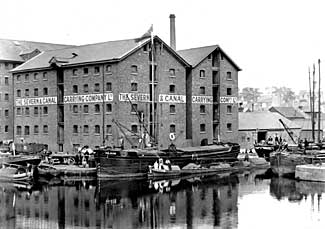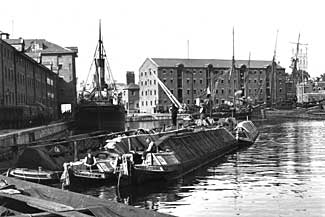|
 Origins Origins
What was
intially known as the Severn & Canal Carrying Shipping &
Steam Towing Company was formed in 1873 by the merger of the
two main firms then carrying general cargoes on the River Severn
– Danks & Sanders and Fellows & Co. Based in Gloucester,
the Company had a small steamer and a dozen sailing barges that
could trade to Bristol, half a dozen lighters which did not
go out into the estuary and about fifty canal boats which could
work up river and through the narrow canals in the Midlands.
They also had four tugs which worked to a regular timetable
towing boats and barges on the river above Gloucester. The Company's
main wharf at Gloucester was initially on Baker's Quay, but
by 1885 they had moved their headquarters to the north side
of the Barge Arm just off the Main Basin (photo right). Here goods brought
by barge from Bristol were trans-shipped into canal boats to
continue inland to Birmingham and the Black Country.
Early Traffic
The
inward traffic was mainly wheat, timber and general cargoes
with some glass sand, rock phosphate and sulphur taken off ships
at Gloucester. The outward traffic included iron, pitch, salt,
blue bricks and general cargoes. At the request of the Coalbrookdale
Iron Company, the Carrying Company took over the up-river barges
of Yates Brothers and carried castings all the way to Bristol.
These included three-legged iron cannibal cooking pots which
were loaded into vessels at Bristol for the Guinea trade. A
most important traffic started in the 1880s when John Lysaght
of Bristol established rolling works at Wolverhampton, and the
Company carried the sheet iron down to Bristol. Over the years
1886 to 1890, the average annual trade handled by the Carrying
Company was 30,395 tons up (including 15,595 tons wood and grain)
and 30,868 tons down, but it was difficult to make a profit
in the face of competition from the railways.
 New Company New Company
With
a view to raising more capital to buy larger vessels, a new
company was formed in 1891 with the shorter title of Severn
& Canal Carrying Company. Unfortuately, the hoped for additional
capital did not materialise and futher financial reorganisations
were needed in subsequent years. However, the Company did purchase
two new river tugs and two barges suitable for use between the
Bristol Channel ports and Worcester. As the Sharpness Dock Company
now provided towing services in the estuary, the old barges
had their sails removed, but each retained its mast and gaff
for handling cargoes.
New Cargoes
At this
time, the bulk of the inward traffic was grain, timber, copper
from Briton Ferry, sugar, glass sand, pyrites, patent manures
and china clay. In 1907, alterations and additions to the Carrying
Company’s warehouse at Worcester Wharf, Birmingham, helped them
to win back from the railways part of the sugar trade coming
into Gloucester on the Bristol Steam Navigation Company ships,
and they also recaptured the glucose trade from Manchester.
The outward traffic included iron bars and plates for Gloucester
and Bristol, red moulding sand from Stourport for foundries
in Gloucester, Newport and Cardiff, pitch to Swansea and Port
Talbot, flour from Gloucester to Swansea and tin plate to Llanelli.
Also stone, coal, salt and patent manure were brought down the
river to Gloucester.
 Set-back Set-back
By 1910
the Company were being offered more traffic than they could
handle, and they bought two motorised barges, Osric (photo
right) and
Serlo, built by Simpson Strickland and Co at Dartmouth
in 1913. These had two cylinder Bolinder engines, and they were
capable of towing the existing dumb barges. However, the first
World War had a devastating effect on the trade passing through Gloucester
as so much of it had come from the continent of Europe, and
the Carrying Company suffered as well. Then in 1923, Cadbury
Brothers agreed to take up new shares, as they had built a factory
beside the Sharpness Canal at Frampton-on-Severn, and they were
keen to support water transport to avoid the railways obtaining
a monopoly.
Boom and Takeover
This
injection of Cadbury money was accompanied by the election of
George Cadbury to the board, and his drive helped to transform
the Carrying Company which was able to clear the accumulated
deficit and move into profit again. New vessels were purchased
and new sources of traffic developed, particularly the carrying
of petroleum, and many Gloucester men were employed on the barges
and canal boats. For details of a typical canal boat trip to
the Midlands, see Going
Up Country. During the Second World War, the Company made a
substantial contribution to the national effort, carrying vital
supplies from the Bristol Channel ports to factories in the
Midlands. However, lacking the backing of further investment
in the post-war period, the Carrying Company was taken over
in 1948 by Lyon and Lyon, who retained the tankers and sold
the dry-cargo vessels to the nationalised British Transport
Commission.
Sources
This account
is based on an article in the Waterways Journal Vol 3 published
by the Boat Museum Society 2001, where sources are given.
|